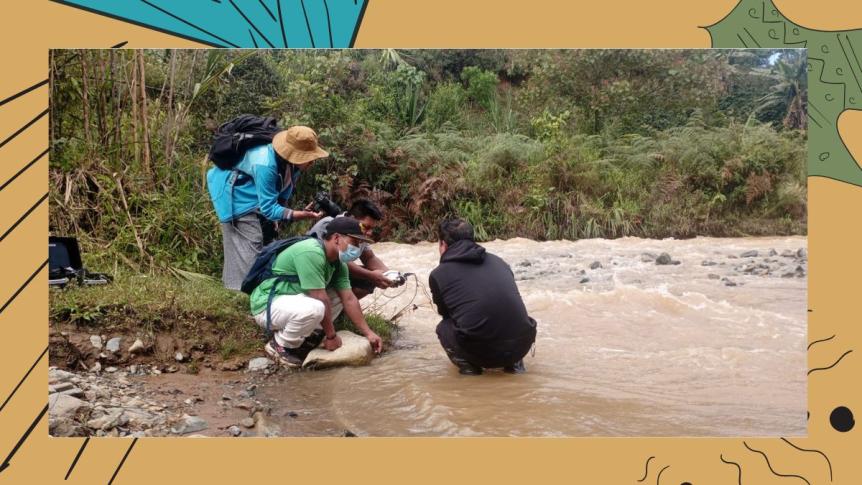
Access to connectivity and devices can be a key factor in enabling communities and promoting local development. Yet technology’s value goes far beyond access: it lies in what communities can create with it. When technologies are not only appropriate but also appropriated and truly shaped by communities, they can become tools for collective well-being, autonomy and care for the environment.
This is the vision behind Transformative Environmental Alert Systems: Improving Sensor Design and Community Involvement, a project led by Colnodo, an APC member in Colombia, with support from APC’s Environmental Sustainability (EnvSus) grant. The initiative builds on Colnodo’s long-standing experience in working with digital inclusion and environmental monitoring to create kits for community networks, whereby local people can monitor, collect and save data, deepening the intersection between community networks, citizen science and technological innovation for sustainability.
To achieve this, Colnodo involved communities that are working in developing processes to test and improve these kits from their perspectives and needs. The communities were Jxa'h Wejxa Casil and RedINC, both from the department of Cauca, where they run community networks, and both partners of the Local Networks (LocNet) initiative.
From early prototypes to improved kits for environmental monitoring, from data collection to community reflection, this story illustrates how technology can be transformed into a tool for environmental stewardship and self-determination. In the words of the Colnodo team behind the project, “Making knowledge accessible and replicable strengthens the processes of appropriation and autonomy being developed by community networks.” With each workshop and sensor assembled, communities like RedINC and Jxa'h Wejxa Casil in Colombia are not just measuring the quality of the air, water and the noise around them – they’re shaping a future where data, care and technology grow together.
Information and communication technologies for community-centred environmental care
Since its creation, Colnodo has promoted the use of information and communication technologies (ICTs) for social inclusion and sustainable development. To strengthen this approach, Colnodo developed the Red de Desarrollo Sostenible (RDS) a platform that connects organisations and citizens with the aim of promoting sustainability through the strategic use of ICTs, enabling the creation of digital tools that connect environmental care with local engagement.
In 2023, with APC’s support, Colnodo developed an environmental alert system linked to a geographic information system (GIS), capable of collecting real-time data on noise and air quality. Later, as part of the Transformative Technologies for People and the Planet collective, it contributed to the creation of a water quality sensor integrated into the same GIS that registers temperature, pH, electrical conductivity and total dissolved solids.
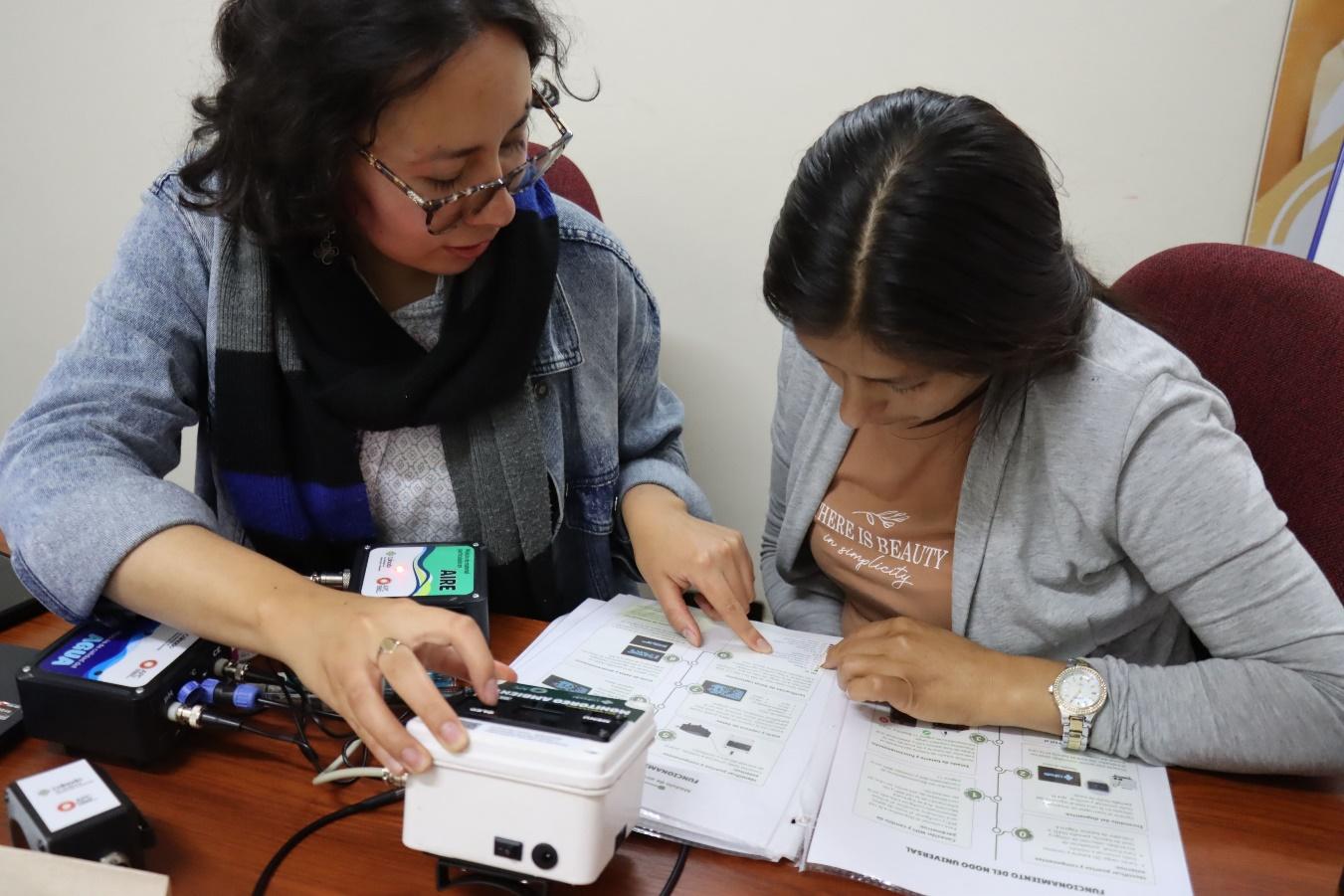
RedINC training session on operation and interpretation of data captured by the particulate matter module. Photo by Colnodo
An important insight emerged from those early prototypes: communities were not only end users but co-developers. For Nathaly Ordóñez from RedINC, the process was also a journey of adaptation. “The first time we received the sensor, it was all messed up... The second time it arrived, it was better and I knew I had to treat it more carefully. But I wish it were stronger so I could leave it outside.”
Their experiences using the first generation of sensors inspired Colnodo to revisit the designs, improve reliability and simplify operations. This process was captured in a “Lessons Learned” document, which was the seed for the next stage.
Learning from communities to improve technologies
With the project supported by APC, Colnodo moved those lessons forward, aiming to create a unified environmental monitoring kit that is both technically robust and more accessible for community use.
The team leading this project, integrated by Julián Casasbuenas G., Plácido Silva and Yuli Betín and the web development team of Colnodo, focus on improving the sensors, in both building and operation. In this new phase, the device has a central module connected to the sensors for noise, air and water quality, while it also integrates wired and wireless data collection.
The key upgrades that this version includes are a new display with expanded information lines, a longer battery autonomy – that lasts from eight to ten hours – and heat protection. The redesign also includes some additional components that facilitate its handling in the field, such as a storage box, protective liners, netting and a universal connector cable.
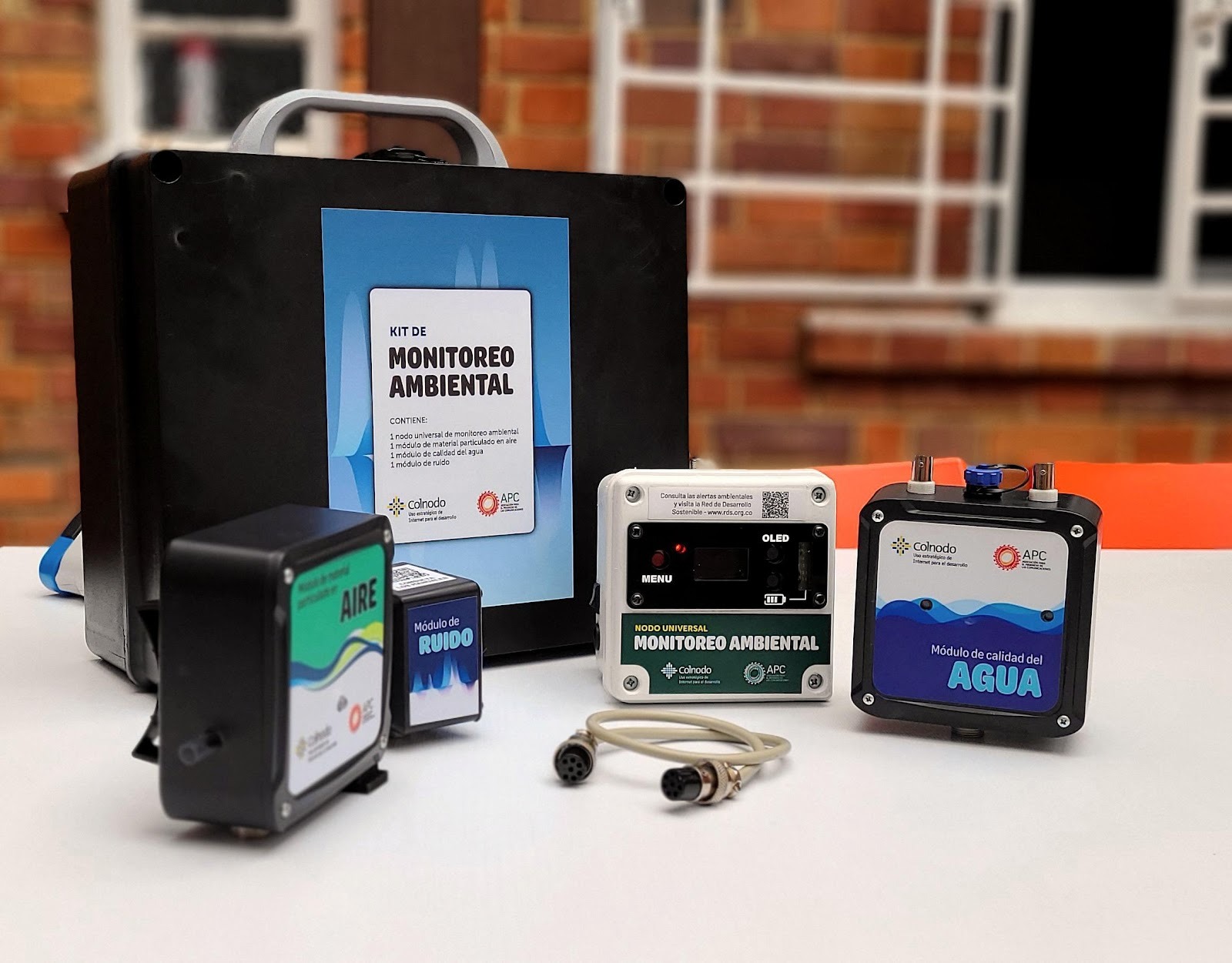
Kit for environmental monitoring, with three different sensors. Photo: Colnodo
Besides the design improvements, Colnodo expects the kits to be easier to use in community networks, as it now has a simplified control panel, compact layout and a single programming code that automatically recognises modules, while universal operating messages and parameterising basic kit configurations were also added. Colnodo highlighted the collaboration with Robotha, a group of industrial designers, to redesign the sensor’s physical structure.
“This reduction of technical complexity for the communities as end users is significant and makes the environmental monitoring kit more affordable and easy to use in different rural scenarios and technological gaps,” explained the team in charge.
Learning by doing: Workshops with community networks
Jxa'h Wejxa Casil and RedINC, both community networks already connected to the internet in Colombia, were involved with the project from its initial steps.
When the new monitoring kits reached their territories, Colnodo facilitated practical and theoretical workshops where community members learned to recognise some internal components and elements behind the kits’ operation. They also test them and interpret data from the new devices. Participants had a hands-on approach – taking sensors apart to understand their components, simulating measurements with water samples and verifying the collected data on the GIS platform.
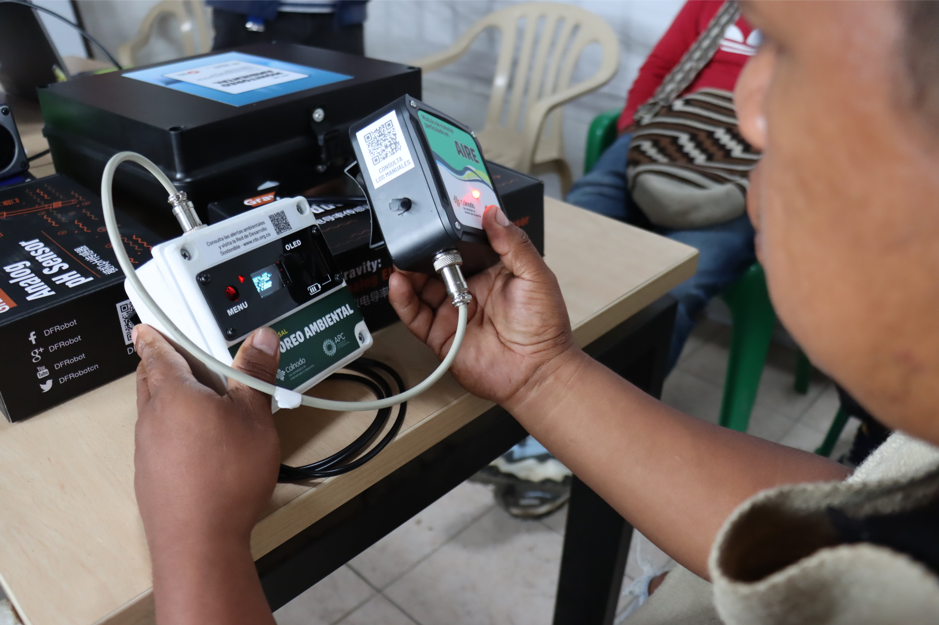
Workshop in the Jxa'h Wejxa Casil community network. Photo: Colnodo.
The sessions also provided great opportunities for collective reflections around two central ideas. One is the importance of capturing environmental data, ensuring the active role of communities in monitoring and interpreting results. The other is understanding these tools as a way to support existing local monitoring efforts, strengthen local autonomy and people’s environmental protection actions.
“One of our goals with these technologies is to see how the climate is changing and how we can reverse or delay it a little bit more, to raise awareness among our community members, with specific data about what happens when trees are burned or cut down,” said Juan Pablo Camayo from the Jxa'h Wejxa Casil community network.
The initiative directly benefits members of the community networks RedINC and Jxa'h Wejxa Casil, both based in rural Cauca. Their involvement since the project’s first phase in 2023 has been essential to the evolution of the devices and their usability.
Access to low-cost monitoring kits allows these networks to collect local environmental data – to better understand phenomena like deforestation or agricultural burning. The data is securely stored on Colnodo’s servers and visualised through the RDS GIS platform, which enables interactive consultation and mapping. This has already promoted a growing awareness in the community and invited local action.
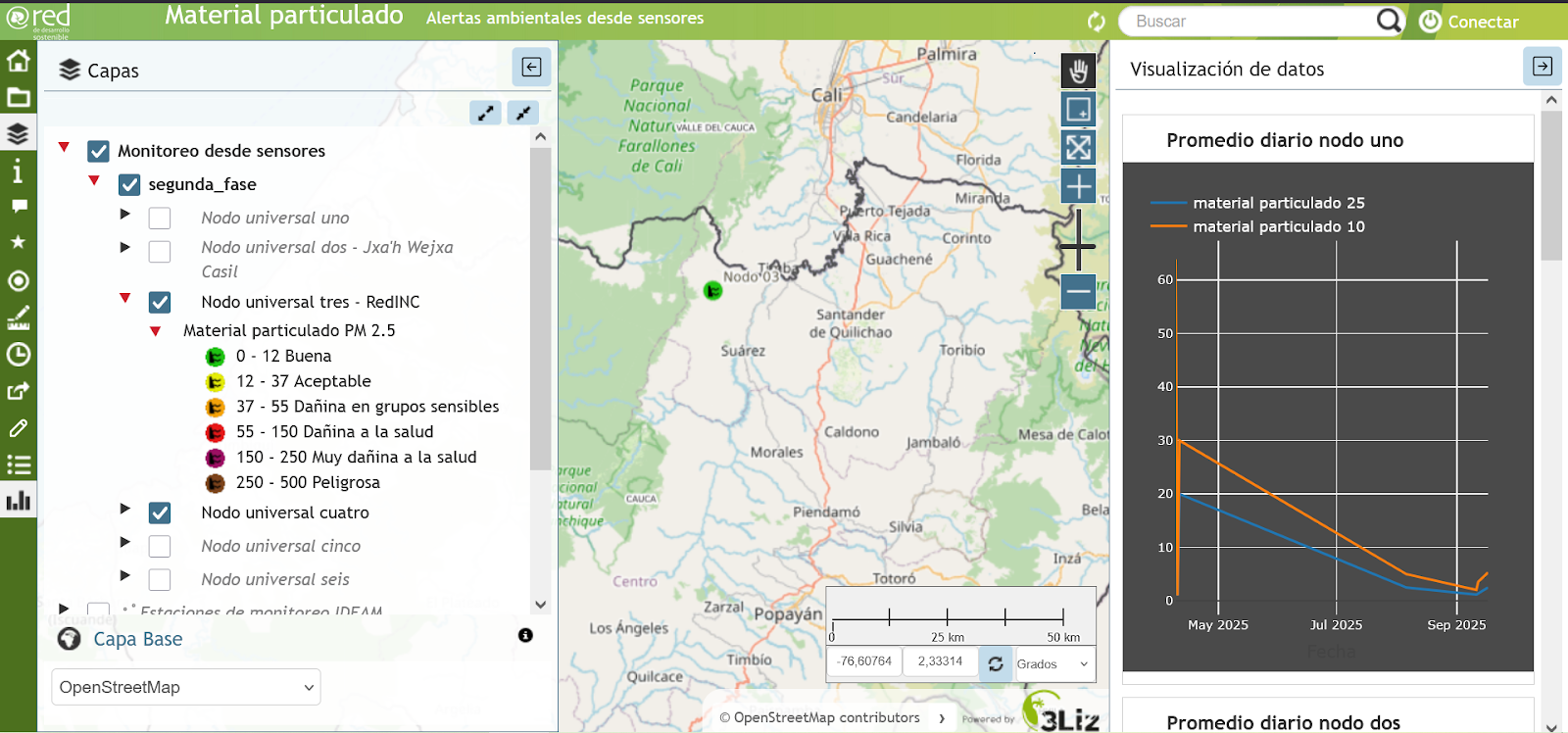
Data visualisation in the GIS system of the Red de Desarrollo Sostenible.
Colnodo also presented the project in more general spaces such as the III Meeting of Community Networks in Colombia and the Girls in ICT Day, reaching new people and inspiring others to engage with citizen-led environmental monitoring. More recently, new editions of the workshop were developed in the implementation of “Red Esmeralda, Semilla Digital”, a new network with Indigenous communities in the department of Córdoba and also in the Camp on Community Communication for the Protection of Life in the Territories, held in the city of Carmen de Bolívar. The community network in La Esmeralda has been supported by Colnodo since June 2025 as part of the LocNet initiative led by APC and Rhizomatica. LocNet is also supporting the improvement of the sensors and the implementation of the kit.
By documenting and sharing the process, Colnodo contributes to the collective knowledge of the APC network, inspiring others to adapt and replicate these tools. These experiences informed new operating manuals – two documents that were developed and are now available for the APC EnvSus group and other organisations that may need them. One focuses on technical aspects like programming and assembly; the other uses simple, visual language to guide end users in communities.
For Colnodo, this project is not just about sensors – it’s about citizen science. “The citizen science approach, combined with the community network ecosystem, mobilises participation in community environmental monitoring processes,” the team said. “Each member plays an active role in preparing, collecting and interpreting data, paving the way for environmental defence of the territories.”
Through this project, technology becomes a language of care – a way for communities to read, understand and protect their environment. As the world prepares for the United Nations Climate Change Conference (COP30) this month, this story invites us to reflect on how connectivity and the development and uses of digital technologies can emerge from the needs of the people living in and defending the environment around them.
This piece is a version of the information provided by Colnodo as part of the project "Environmental Alerts", adapted for the Seeding Change column. This column presents the experiences of APC members and partners who were recipients of funding through grants and subgrants offered through APC projects and initiatives. Did this story inspire you to plant seeds of change in your community? Share your story with us at communications@apc.org